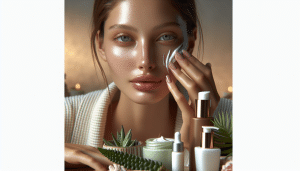Secrets of Glowing Skin You Rarely Hear
Natalie Brooks October 25, 2025
Unlock practical insights into glowing skin—beyond basic routines and trends. This guide explores skincare science, ingredient tips, daily rituals, holistic wellness, hydration, and emerging treatments that people seek out for sustainable radiance. Learn what influences real skin health and discover what truly works.
Understanding the Science of Glowing Skin
Glowing skin doesn’t simply come from a single product. It’s a result of numerous factors working in harmony within your body and lifestyle. Skin is the body’s largest organ and acts as the first line of defense against environmental stressors. What people often overlook is the way cellular turnover, natural oils, and the skin barrier contribute to that healthy, luminous look. Many dermatologists emphasize that a radiant complexion starts with supporting your skin’s biological processes. When moisture levels are balanced and dead skin cells are efficiently shed, the face reflects more light—creating what’s known as a glow. Optimizing conditions for these processes is key to lasting results (Source: https://www.aad.org/public/everyday-care/skin-care-basics/care/skin-care-tips).
Several elements impact natural radiance. Factors such as stress, poor sleep, unbalanced nutrition, and harsh cleansing routines disrupt the skin barrier. This barrier locks in moisture and keeps irritants out. When it’s damaged, dullness, redness, or sensitivity often appear. Those seeking lasting glow focus on protecting the barrier with gentle cleansers, antioxidant serums, and SPF. Experts agree: UV exposure accelerates visible aging and undermines radiance. That’s why sunscreen is a daily staple recommended in many successful skin routines (Source: https://www.fda.gov/consumers/consumer-updates/sunscreen-how-help-protect-your-skin-sun).
Another pillar of glowing skin is consistent cell renewal, or skin cell turnover. Regular turnover helps maintain an even tone and smooth texture. This process naturally slows with age but can be supported by exfoliating acids such as glycolic acid or lactic acid. However, over-exfoliation should be avoided as it can disrupt the skin’s protective barrier. A balance between exfoliation and moisture is what many experts recommend for maintaining glow. Regular checkups with a dermatologist offer personalized ways to help optimize the skin’s natural rhythms without harm (Source: https://www.health.harvard.edu/staying-healthy/skin-care-tips-for-your-40s-and-50s).
Daily Routines That Enhance Radiance
Establishing an effective skincare routine is vital for lasting radiance. Many people find that a simple sequence—cleansing, applying a hydrating toner, serums, moisturizer, and sunscreen—is enough for daily care. Gentle morning cleansing removes overnight oil while maintaining natural lipids. Evening rituals often incorporate double-cleansing if sunscreen or makeup was worn. These routines emphasize respecting the skin barrier and adapting to changing needs across seasons (Source: https://www.womenshealth.gov/a-z-topics/healthy-skin).
Adding antioxidant serums—such as those containing vitamin C or niacinamide—to morning routines has become popular due to their ability to neutralize free radicals and brighten uneven tone. Nightly routines may introduce retinoids or peptide-based serums, which are backed by research for supporting collagen and refining skin texture. Customization is crucial since skin can respond uniquely to active ingredients. If irritation or dryness appears, consider adjusting frequency or switching to gentle versions. Over time, building a routine based on your skin’s feedback can be more effective than chasing trends.
Moisturizing is non-negotiable for glowing skin. Hydrators such as glycerin, hyaluronic acid, and squalane replenish water content, plumping up the skin and improving surface reflections. For those with dry skin, richer creams in the evening can lock in moisture. Oily or combination types might find light gels more suitable. Listening to the skin’s evolving needs is the core philosophy many skincare experts endorse. Consistency, rather than frequent product swaps, is more likely to bring lasting radiance. Smart use of daily rituals sets a foundation for further enhancements.
The Power of Skincare Ingredients
Knowing which ingredients to prioritize can make everyday skincare more effective. Ingredients such as vitamin C, retinol, hyaluronic acid, and ceramides come highly recommended in dermatological studies for their visible impact on skin health. Vitamin C boosts brightness and aids collagen production; retinoids accelerate cell turnover and help fade marks. Together, these ingredients target common issues like dullness, uneven tone, and fine lines.
Hyaluronic acid is celebrated for its profound hydrating ability, drawing moisture to the upper layers of the skin. This molecule occurs naturally in the body but depletes with age. Many moisturizers and serums include multiple weights of hyaluronic acid for both surface and deeper hydration. Ceramides, meanwhile, are lipids essential for a strong skin barrier. According to ongoing research, using products containing these ingredients can help the skin resist external stressors and maintain a soft glow (Source: https://www.ncbi.nlm.nih.gov/pmc/articles/PMC7312923/).
Skincare ingredient education extends beyond reading labels. Certain combinations enhance potency, like vitamin C with vitamin E (boosting antioxidant effects) or niacinamide calming potential redness from retinoids. However, overloading with too many actives can backfire and lead to irritation. Many find that starting slow, introducing one new ingredient at a time, offers a better chance for skin to adjust and yield that coveted glow. If adverse reactions occur, dermatologists can help tailor the ingredient mix to personal needs and sensitivities.
Holistic Practices for Skin Wellness
Radiant skin extends beyond topical care. Holistic wellness—including balanced nutrition, stress management, and sleep hygiene—has a measurable impact on overall complexion. Dietary choices rich in antioxidants, omega-3 fatty acids, and hydration support vital skin functions from within. Several studies link diets high in fruits, vegetables, healthy fats, and whole grains to a lower risk of premature skin aging (Source: https://www.nia.nih.gov/health/skin-care-and-aging).
Chronic stress disrupts hormones and can trigger increased oil production and conditions such as acne or eczema. Techniques such as meditation, mindfulness, or gentle physical activity may help reduce cortisol, which benefits both mind and skin. For some, tracking stress and flare-ups helps reveal patterns, enabling better skin and self-care management. Professionals recommend regular sleep as well. During sleep, the body repairs tissues and produces collagen, essential for firmness and glow. Prioritizing sleep often leads to noticeable improvements in skin texture within a few weeks.
Limiting exposure to pollutants, tobacco, and alcohol are other crucial holistic strategies for people striving for glow. These substances accelerate oxidative stress, leading to visible dullness and early lines. Those committed to glowing skin typically focus on small, consistent life changes—swapping out sugary drinks for water, opting for restorative sleep, and adding regular movement to daily life. Holistic care complements topical routines and supports long-term wellness and radiance from within.
Hydration: The Often Overlooked Glow Factor
Hydration is often cited as a simple yet potent method to achieve glowing skin. Skin cells function best when properly hydrated—internally and externally. Drinking enough water maintains skin elasticity and buoyancy. Slight dehydration can contribute to a flat, fatigued appearance. Environmental factors such as heating, air conditioning, and wind draw water from the skin, requiring ongoing attention (Source: https://www.cdc.gov/nutrition/data-statistics/know-your-limit-for-added-sugars.html).
External hydration works through thoughtfully chosen skincare products. Humectants pull moisture from the environment into the skin, while occlusives help lock it in. Gels and lotions with humectants (such as glycerin or hyaluronic acid) deliver immediate plumping effects. Those living in dry climates may benefit from layering a rich cream at night to slow water loss from the skin surface. Regular use of a humidifier can further buffer environmental dehydration, especially in homes with central heating or cooling.
Tracking daily water intake—alongside adjusting skincare routines—can yield significant changes in texture, smoothness, and natural radiance. Whenever dullness is observed, evaluating hydration habits is often the easiest and most overlooked fix. Staying consistent with both internal and external hydration habits helps support all other radiance-boosting strategies outlined in this guide.
Emerging Treatments and Technology for Skin Glow
Innovations in aesthetics are changing how some people approach glowing skin. Non-invasive treatments such as LED light therapy, microcurrent facials, and gentle resurfacing provide new ways to enhance glow without aggressive downtime. LED therapy, for example, uses specific wavelengths to energize skin cells and reduce inflammation. Research supports its use for improving tone and stimulating collagen, crucial for a luminous look (Source: https://www.ncbi.nlm.nih.gov/pmc/articles/PMC8386018/).
Another popular approach is microneedling, which creates tiny punctures in the skin to prompt natural healing and boost collagen production. This minimally invasive technology, when performed by trained professionals, may reduce scarring, smooth wrinkles, and heighten overall luminosity. Advances in ultrasound and radiofrequency devices offer more tools for skin tightening and brightening, particularly for those with stubborn dullness or textural issues. However, it’s important to consult licensed skincare providers to determine which technology aligns with specific goals and skin types.
Professional-grade skincare (including at-home devices) has also become more accessible for appearance-conscious individuals. Many choose to combine daily topical regimens with periodic aesthetic treatments, creating a customized approach for lasting radiance. As with all innovations, reviewing outcomes and potential risks with a board-certified dermatologist or licensed provider is recommended. The synergy between proven basics and technology-driven treatments presents a powerful opportunity to maintain glowing skin across diverse age groups and lifestyles.
References
1. American Academy of Dermatology. (n.d.). Skin care tips. Retrieved from https://www.aad.org/public/everyday-care/skin-care-basics/care/skin-care-tips
2. U.S. Food and Drug Administration. (n.d.). Sunscreen: How to help protect your skin from the sun. Retrieved from https://www.fda.gov/consumers/consumer-updates/sunscreen-how-help-protect-your-skin-sun
3. Harvard Health Publishing. (n.d.). Skin care tips for your 40s and 50s. Retrieved from https://www.health.harvard.edu/staying-healthy/skin-care-tips-for-your-40s-and-50s
4. Women’s Health. (n.d.). Healthy skin. Retrieved from https://www.womenshealth.gov/a-z-topics/healthy-skin
5. National Institute on Aging. (n.d.). Skin care and aging. Retrieved from https://www.nia.nih.gov/health/skin-care-and-aging
6. National Center for Biotechnology Information. (2020). Hyaluronic acid in skin care. Retrieved from https://www.ncbi.nlm.nih.gov/pmc/articles/PMC7312923/








